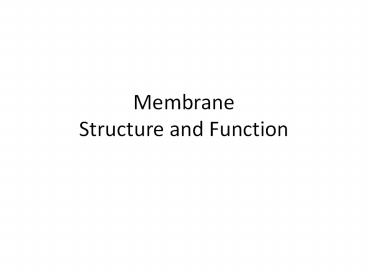Membrane Structure and Function - PowerPoint PPT Presentation
Title:
Membrane Structure and Function
Description:
Membrane Structure and Function * Figure 7.9 The structure of a transmembrane protein. * * Figure 7.10 Some functions of membrane proteins. * Figure 7.10 Some ... – PowerPoint PPT presentation
Number of Views:30
Avg rating:3.0/5.0
Title: Membrane Structure and Function
1
MembraneStructure and Function
2
Overview Life at the Edge
- Plasma membrane is boundary that separates living
cell from surroundings - Plasma membrane is selective permeability
3
Cellular membranes are fluid mosaics of lipids
and proteins
- Phospholipids
- most abundant lipid in plasma membrane
- amphipathic molecules
- Fuid mosaic model
- membrane is a fluid structure with mosaic of
various embedded proteins
4
Figure 7.2
WATER
Hydrophilichead
Hydrophobictail
WATER
5
Figure 7.3
Phospholipidbilayer
Hydrophobic regionsof protein
Hydrophilicregions of protein
6
- Freeze-fracture studies of the plasma membrane
supported the fluid mosaic model - Freeze-fracture is specialized preparation
technique that splits membrane along the middle
of phospholipid bilayer
7
Figure 7.4
TECHNIQUE
Extracellularlayer
Proteins
Knife
Plasma membrane
Cytoplasmic layer
RESULTS
Inside of cytoplasmic layer
Inside of extracellular layer
8
The Fluidity of Membranes
- Phospholipids membrane can move within bilayer
- Most of the lipids, and some proteins, drift
laterally - Rarely does a molecule flip-flop transversely
across the membrane
9
Figure 7.5
Fibers of extra-cellular matrix (ECM)
Glyco-protein
Carbohydrate
Glycolipid
EXTRACELLULARSIDE OFMEMBRANE
Cholesterol
Microfilamentsof cytoskeleton
Peripheralproteins
Integralprotein
CYTOPLASMIC SIDEOF MEMBRANE
10
Figure 7.6
Flip-flopping across the membraneis rare (? once
per month).
Lateral movement occurs?107 times per second.
11
Figure 7.7
RESULTS
Membrane proteins
Mixed proteinsafter 1 hour
Mouse cell
Human cell
Hybrid cell
12
Figure 7.8
Fluid
Viscous
Unsaturated hydrocarbontails
Saturated hydrocarbon tails
(a) Unsaturated versus saturated hydrocarbon tails
(b) Cholesterol within the animal cell
membrane
Cholesterol
13
Membrane Proteins and Their Functions
- Peripheral proteins bound to surface of membrane
- Integral proteins penetrate the hydrophobic core
- Integral proteins that span the membrane are
called transmembrane proteins - The hydrophobic regions of an integral protein
consist of one or more stretches of nonpolar
amino acids, often coiled into alpha helices
14
Figure 7.9
EXTRACELLULARSIDE
N-terminus
? helix
C-terminus
CYTOPLASMICSIDE
15
- Six major functions of membrane proteins
- Transport
- Enzymatic activity
- Signal transduction
- Cell-cell recognition
- Intercellular joining
- Attachment to the cytoskeleton and extracellular
matrix (ECM)
16
Figure 7.10
Signaling molecule
Receptor
Enzymes
ATP
Signal transduction
(a) Transport
(b) Enzymatic activity
(c) Signal transduction
Glyco-protein
(e) Intercellular joining
(f) Attachment to the cytoskeleton and
extracellular matrix (ECM)
(d) Cell-cell recognition
17
Figure 7.10a
Signaling molecule
Receptor
Enzymes
ATP
Signal transduction
(b) Enzymatic activity
(c) Signal transduction
(a) Transport
18
Figure 7.10b
Glyco-protein
(e) Intercellular joining
(f) Attachment to the cytoskeleton and
extracellular matrix (ECM)
(d) Cell-cell recognition
19
The Role of Membrane Carbohydrates in Cell-Cell
Recognition
- Cells recognize each other by binding to surface
molecules, often containing carbohydrates, on the
extracellular surface of the plasma membrane - Membrane carbohydrates may be covalently bonded
to lipids (forming glycolipids) or more commonly
to proteins (forming glycoproteins) - Carbohydrates on the external side of the plasma
membrane vary among species, individuals, and
even cell types in an individual
20
Figure 7.11
HIV
Receptor(CD4)
Receptor (CD4)but no CCR5
Plasmamembrane
Co-receptor(CCR5)
HIV can infect a cell thathas CCR5 on its
surface,as in most people.
HIV cannot infect a cell lackingCCR5 on its
surface, as in resistant individuals.































